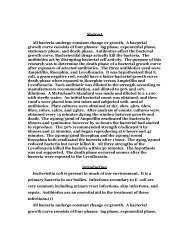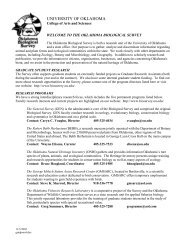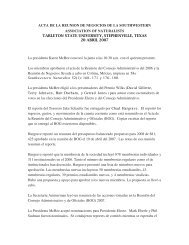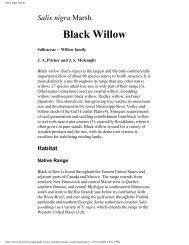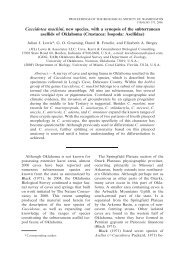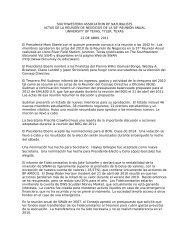Mary Masterman - Oklahoma Biological Survey - University of ...
Mary Masterman - Oklahoma Biological Survey - University of ...
Mary Masterman - Oklahoma Biological Survey - University of ...
Create successful ePaper yourself
Turn your PDF publications into a flip-book with our unique Google optimized e-Paper software.
Materials and Methods<br />
6<br />
Primary Materials<br />
Drill press with various drill bits, C-clamps, taps, and screws; Lathe with 3-jaw and 4-jaw chucks; Various scrap aluminum<br />
tubing, L-brackets, and plates; Black foamie w/ double-stick tape; Canon EOS 300D digital camera; 300 mm medium-format<br />
camera lens; Mounting board with aluminum rails; 1200 lines / mm 5 cm^2 diffraction grating; Vice and files; Saw; Hand-drill;<br />
Canon 50 mm camera lens; Chroma Corporation filter set (including barrier filter, excitation filter, and dichroic mirror); Thin brass<br />
sheet to hold dichroic mirror in place; Canon 67 mm filter to hold barrier filter; 532 nm 5 mW green laser; Red laser, level, and ruler<br />
(for calibration); Flat diagonal mirror with adjustment screws; Micrometer head (to adjust angle <strong>of</strong> grating).<br />
Methods<br />
Build Raman filter cube using square aluminum tubing. Carefully contruct brass sheet to hold dichroic mirror and drill holes in<br />
filter cube for other filters. Very carefully, and with gloves, slide dichroic mirror into brass sheet so that it is at a 45° angle to filter<br />
cube. Construct mounting board for Raman system using large wood board and aluminum rails. Attach lenses to rails using L-<br />
brackets and and attach to mounting board. Construct holder for laser using aluminum tubing and screws. Attach barrier filter to lens<br />
using 67 mm filter holder. Attach excitation filter to laser holder. Align optical system.<br />
Construct backing-ring to attach Pentax 6x7 ring to Canon EOS 300D Camera. Construct holder for diagonal on lathe using<br />
round aluminum tubing. Attach diagonal mirror to holder using double-stick tape. Construct grating holder using micrometer head,<br />
brass rod for grating to turn on, and part <strong>of</strong> an aluminum L-bracket. Attach grating with double-stick tape. Align optical system.<br />
Attach spectrograph to Raman head. Collect spectra. In the Raman system, the dichroic mirror was not initially at the correct 45º<br />
angle, so that the filter cube had to be made tiltable and separate holders for the barrier and excitation filters had to be constructed.<br />
Due to the necessity <strong>of</strong> placing the invisible Raman signal on the slit <strong>of</strong> the spectrograph, alignment <strong>of</strong> the Raman system’s<br />
optical path was very challenging. The Raman system didn’t work at all until the sample focusing lens was replaced with a<br />
microscope objective, which presumably dramatically intensed the intensity <strong>of</strong> the laser beam on the sample. It was very difficult to<br />
design the Littrow spectrograph such that the diagonal and SCT ring would fit in the flange-to-film distance <strong>of</strong> the lens, partly<br />
because the distance was not as published.<br />
Alignment <strong>of</strong> the diagonal mirror so that the entrance image <strong>of</strong> the spectrograph resulted in a centered and focused image on the<br />
camera chip proved to be tedious.



